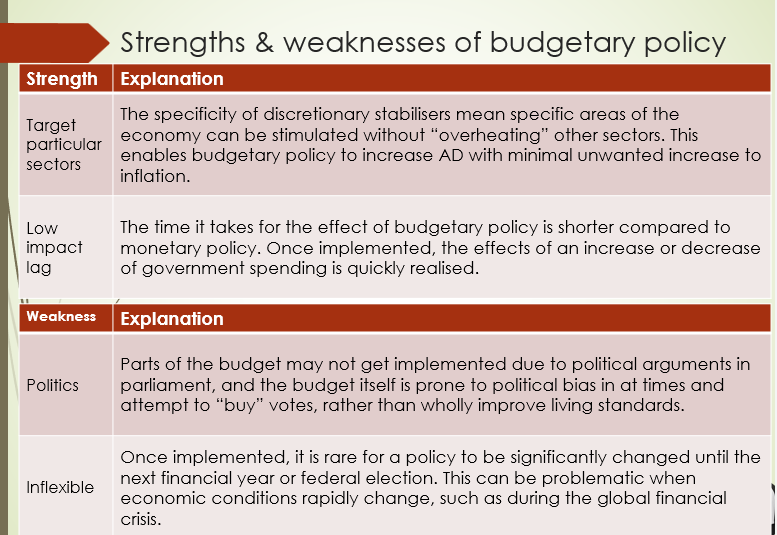ECO Unit 4 outcome 1
1/35
There's no tags or description
Looks like no tags are added yet.
Name | Mastery | Learn | Test | Matching | Spaced |
|---|
No study sessions yet.
36 Terms
Direct taxation
Revenue received on the income of or profits of the person who pays it. E.g Income tax, company tax, superannuation fund tax
Indirect taxation
Revenue received from the sale of goods or services. E.g GST, Tariffs, Excise tax
Progressive tax
Those that narrow the gap between individuals on higher as opposed to lower incomes. E.g personal income tax system (those on low income below a certain number are not taxed. People on higher numbers are taxed alot more.)
Regressive tax
Taxes that increase income inequality, being opposite to progressive taxes.
Proportional tax
Remains constant no matter how much or how little income is earned. An example of a proportional tax is company tax where large businesses pay at the rate of 30 per cent of each dollar of profit, while small and medium enterprises (SMEs) now pay 25 per cent.
Revenue from GBE’s
Revenue received from the profits of businesses owned by the gov. E.g Aus post profits
Revenue from sale of gov assests
Revenue received when items under control of the gov are sold. E.g sale of the ABC (hypothetical)
GOV EXPENSES
Current expenditure
Capital expenditure
Transfer payments
Current expenditure
Day-to-day operating costs of gov departments, with benefits consumed within a 12 day period. E.g Wages, salaries, stationary, rent.
Capital expenditure
Expenses paid by the gov on g&s that have a benefit for longer than a 12 month period. E.g Building of schools, uni, airports, roads.
Transfer payments
A government payment made in which no g&s are received in exchange. E.g Pension, unemployment benefit, housing assistance, disability payment.
Budget outcome
Reflects difference in value between gov receipts and outlays for the year
Balanced budget
When gov receipts and expenditure are equal.
R/S to debt
N/R.
Budget deficit
When gov expenditure is greater than receipts.
R/S to debt
Debt+ through sale of gov bunds to fund shortfall.
Budget surplus
When gov receipts are greater than expenditure.
R/S to debt
Debt’s MAY reduce if gov chooses to use surplus to pay down debt. Other option is to return money to economy for short run or long run benefits.
3 Ways for gov to finance deficit
Selling bonds to RBA
Selling bonds to Aus investors
Selling bonds to overseas investors
Selling bonds to RBA
Asking RBA to print more money, increasing supply of money into economy once the gov starts to spend the money received. This has negative effects on inflation, with prices articifially + due to market forces with negative effects on GDP
Selling bonds to Aus investors
Process removes money from the economy, making it more scarce. This means price of money (interest rate) rises, affecting investment and priv consumption negatively. This results in fall in AD & GDP
Selling bonds to overseas investors
Process increases demand for Aus currency, as borrowed cash is converted to AUD. This means price of AUD appreciates, making it relatively more expensive for overseas eco agents. This means AU exports = more expensive, -X and +M, causing fall in AD & GDP
Effects on goals
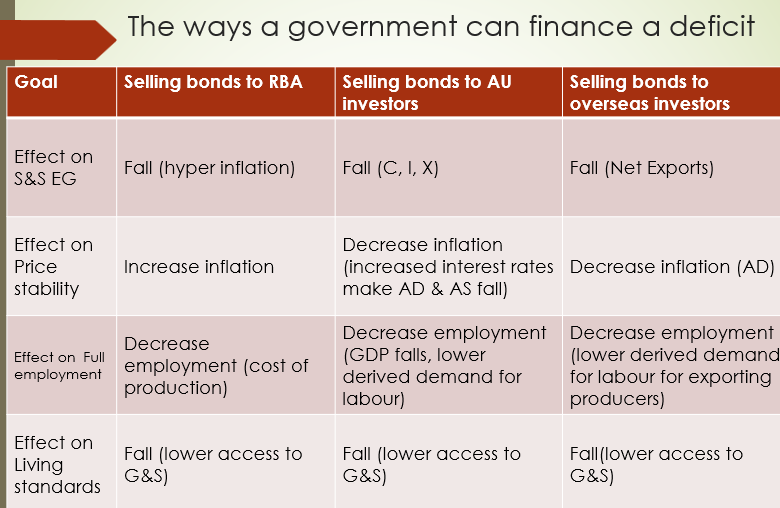
Ways a gov can utilise a surplus
Invest in financial markets
Repay existing debt
Return to economy next time
Place into specific purpose funds
Invest in financial markets
Buying of gov bonds to domestic or overseas investors
ADV
Future interest repayments can be received in times of deficit
Repay existing debt
Paying down of existing debt used previous to fund budget deficits
ADV
Improvement in credit rating, reduced interest rates, sovereign solvency
Return to economy next time
Either increasing expenditure or lowering receipts through discretionary budget measures next budget
ADV
Stimulate eco growth and achievement of domestic macroeconomic goals
Place into specific purpose funds
Investment into nation-building funds to improve inter-temporal efficiency
ADV
Helps grow nations sovereign wealth making future payouts possible for important national projects
Effect of a deficit on level of gov public debt
Increase in public debt due to gov needing to borrow money to cover the difference, accumulating debt over time. Repeated deficit = steady increase in overall level of gov debt.
Effect of a surplus on level of gov public debt
Decreases level of gov public debt as surplus can be used to repay or buy back gov debt, reducing amount of outstanding debt.
Automatic stabilisers
Change in budget receipts or expenditure that boost or slow AD and eco activity without federal treasurer purposely changing their level or announcing new policies. E.g Unemployment benefits GST received
AS p1
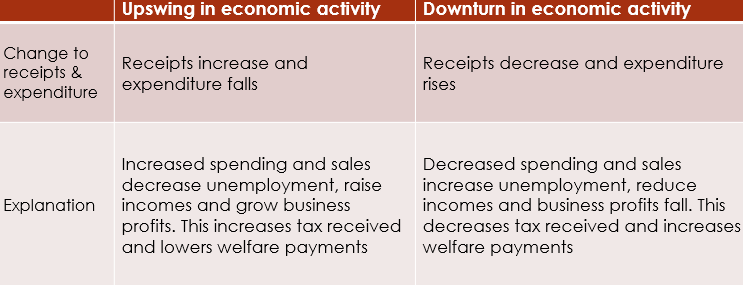
AS p2
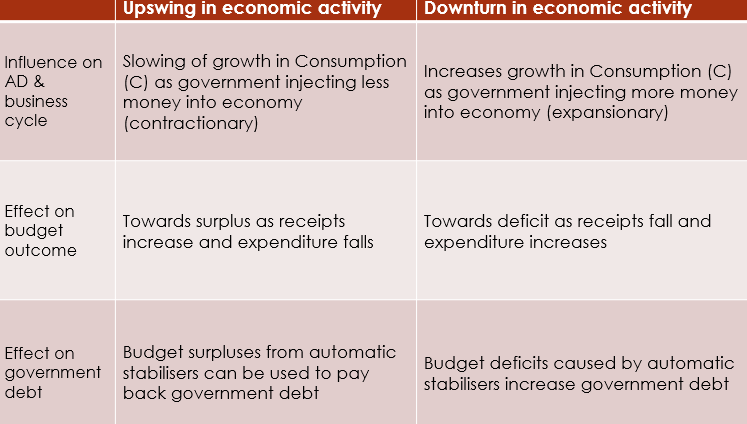
Discretionary stabilisers
Deliberate changes to budget receipts and outlays. E.g Tax rates, welfare payment thresholds, infrastructure.
DS p1
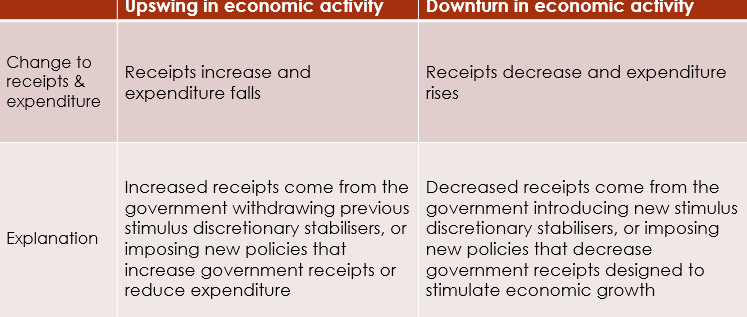
DS p2
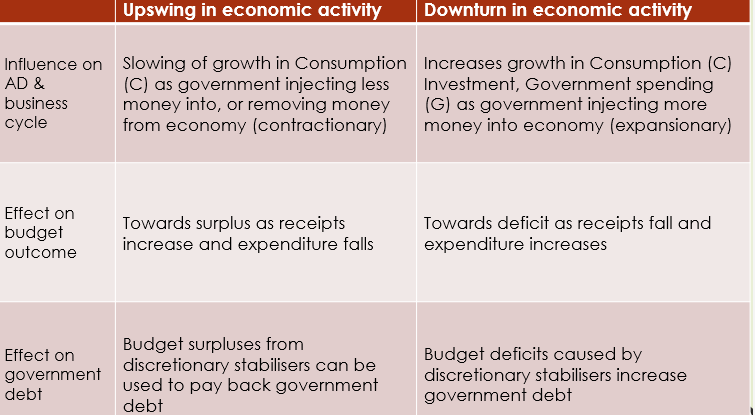
Budgetary policy
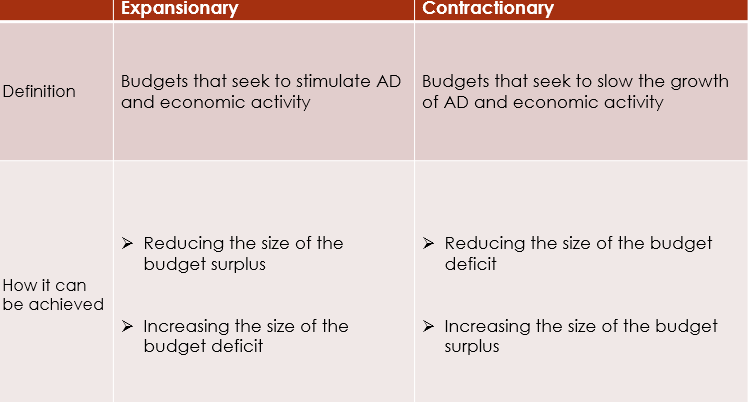
Effect of budgetary initiatives on goals
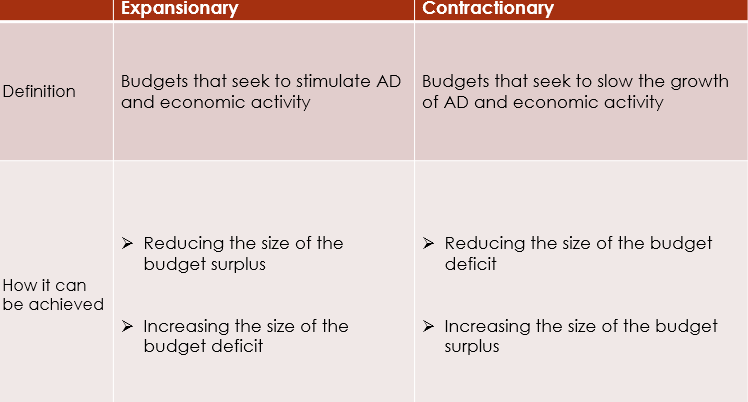
Adv and disadv of budgetary policy
